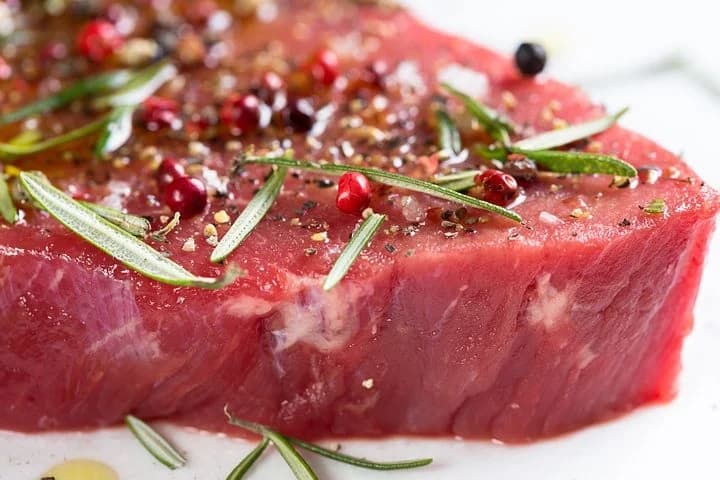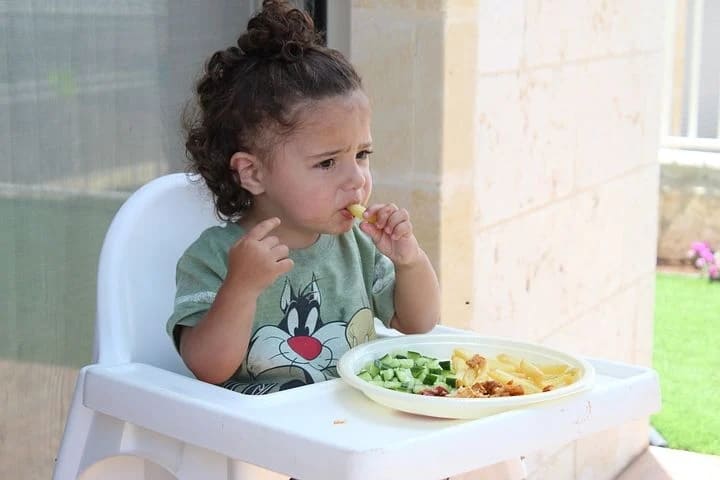My Toddler Won’t Eat Meat – How To Get Them To Start
If you are here, you’ve probably asked yourself why your toddler won’t eat meat. Not to worry, this comprehensive guide is here to help.
As a toddler, your child is discovering what they like or don’t like. Therefore, expect them to have preferences for some foods over others.
We understand it can be a challenge if your toddler refuses to eat some meals, especially if they are rich in a component that they require. Meat for instance, is a protein-rich meal and your toddler needs protein for energy and muscle development.
That’s why it becomes a challenge when your child refuses to eat meat. Here, you’ll learn more about why your toddler refuses to eat meat and how you can cope to worry less about their health.
What Should I Do If My Toddler Refuses to Eat Meat?
This is the primary question that most parents with toddlers that refuse to eat meat struggle with. Once this can be answered, anything related to this is manageable going forward.
There are a lot of reasons why your toddler might refuse to eat meat, which range from health issues to just personal preferences. But before getting to that, let’s find out what you should do if your toddler refuses to eat meat.
According to BabyCenter and other dietitians, meat contains vital nutrients for the human body. Some of them include zinc, iron, proteins, and B vitamins.
As a result, most children who refuse to eat meat end up lacking in one or all areas that the above nutrients help in.
The Texture of the Meat Could Be the Issue
Some toddlers refuse to eat meat due to the texture, which can sometimes be a bit hard.
Due to such, you may notice that your child likes eating chicken meat more than beef. But when it comes to a higher protein, zinc, and iron count, meat like beef, lamb, and pork are the best options for your toddler.
So, if your child refuses to eat meat because of a hard texture, try serving them softer and tender meat. You can try cooking for them the pork tender loin as it’s softer and tastier as well.
Besides that, cooking any kind of meat slowly in casseroles and stew makes it softer. This ensures that you serve your toddler nothing but soft and tastier meat.
The point here is to align the meat to your toddler’s texture preferences. Like you can use sausages, minced meat, burgers, or meatballs because they have a high lean meat content, which is usually softer.
Note that cheaper meat varieties usually lack enough nutrients and lean meat, which are highly essential for your toddler. They also have more fat and gristle that won’t add any health value to your child.
Therefore, you should try as much to avoid them completely if you want meat to be a healthy diet for your toddler.

Your Toddler Could Be Uncomfortable with the Meats Flavor
Besides texture, your toddler might also be refusing to eat meat because of its flavor.
At first, your toddler might easily get irritated by the smell and taste of meat. That can be expected since it’s their first time tasting something like that.
However, you can easily turn that into a win and keep on introducing to them small amounts whenever you are eating. If they tasted the first time then they might do so bit by bit until they learn to love eating meat.
It’s a practice that most dietitians have suggested and has worked really well for ages, and not just for meat but other foods as well. But if your child totally refuses to eat meat, you can think of substituting with foods in the similar group.
Some of them include fish, nuts, eggs, and pulses such as baked beans, red kidney beans, chick peas, and lentils, among others. These have the same amount of nutrients like meat but they also lack a considerable amount of iron.
So, if you decide to substitute meat with the above-mentioned meals, ensure that you include foods with a higher level of Vitamin C. This will help your toddler absorb more of the iron that the mentioned foods contain.
To help you out, below are some of the foods that are rich in Vitamin C:
- Kiwi fruit
- Citrus fruit
- Strawberries
- Tomatoes
- Blackcurrants
- and Potatoes, though not too rich
For optimal iron consumption, you can try feeding your toddler iron fortified breakfast cereals and leafy vegetables.

Your Toddler’s Protein Needs
Needless to say, protein consumption is highly essential for your toddler’s overall development. It helps in muscle growth and energy among other essential functions within your toddler’s body.
As a result, they need to consume a significant amount of protein daily for their benefit. And according to ‘mama knows nutrition’, the best way of estimating how much protein your toddler requires daily is by dividing their total weight in half.
So, if your toddler weighs 40 pounds, they would require 20 grams of proteins each day to meet the average amount. Note that this is only estimation but one that can help you get better results also.
As explained earlier, there are plenty of other foods that you can substitute meat with for your child to still consume protein. However, your toddler misses a lot of iron whenever they refuse to eat meat.
Just like protein, iron is highly essential for your child’s growth and development in many areas. Most dietitians and pediatricians advise parents to ensure that their toddlers are well fed with iron-rich foods.
This is especially a requirement to children who were born before their time or those who had a low birth weight. That’s because children from both scenarios usually have a lesser iron count running in their bodies.
Such information shouldn’t prompt you to immediately fetch an iron supplement from the store. You can easily deal with this problem with the food that your toddler eats, which is the primary solution in most cases.
Meat, poultry, and fish are some of the best sources of iron, meaning that your toddler can really benefit from eating such meals.

Vegetables Rich In Iron
Other than that, there are also vegetables that are highly rich in iron.
You can feed them to your toddler if they’ve totally refused to eat meat at this stage. According to Forbes, your toddler can still get the nutritional equivalent of meat from plant based diets. Below are some of the iron-rich vegetables that you can substitute meat with and ensure that your child gets the needed amount of iron.
- Spinach
- Soy or tofu
- Swiss chard
- Leeks
- Romaine Lettuce
- Lentils
- Beans
- Peas
- Hummus
- Olives
- Tomatoes
- Broccoli
- Sesame seeds
- Green beans
- Fortified cereals
- Chickpeas
- Pumpkin seeds
- Beets
- Turmeric
- Parsley
- and Asparagus
You can use either of the above options as a meat substitute to ensure that your toddler gets the deserved amount of iron. Some might be hard to find, while others even harder to prepare.
However, if you can find one, two or more that are easily available and easy to prepare, then you’ll be at a better place. But just like meat, your toddler might also be picky and decide otherwise.
So, consider their preferences as well to decide which one will work best for better results in the end. You can also check with a pediatrician to see which iron-multivitamins are good for your toddler.

How to Get Your Toddler to Eat Meat
At this point, you know the benefits of eating meat for your toddler and some of the substitutes if they refuse to eat altogether. But what if your toddler has an interest but doesn’t know how to maneuver the right way.
Like mentioned earlier, your child might not be fond of the idea of eating meat at first. It’s a new taste and a new texture as well they are trying.
So, expect them to be a bit unexcited about the idea. On the other hand, use that as an opportunity to see if they can get used to the idea of eating meat.
The only thing you shouldn’t do is try to force them into eating meat. Let it happen naturally by incorporating it in their meals little by little.
Below, you’ll learn how to get your toddler to eat meat regardless of the type. Note that you don’t have to keep on trying the ideas often.
You can skip for some few weeks and then try getting them back to the routine like it’s their first time. So, here are some ideas to get your toddler eating meat continuously without ever disregarding the idea.
- Start Soft and Tasty
It’s no doubt that meat is one of the tastiest delicacies known to mankind. Therefore, your toddler might be easily lured in with taste but thrown off by texture.
This is where you need to start introducing meat to your toddler the right way by serving them tender and tastier meat. When you do this, they might easily get fond of the idea and consume meat more often.
You can start with thin slices of ham or turkey because these are usually tender meat but also tasty. Try these for a while and if it goes well then you can slowly try incorporating different kinds of meat to your toddler’s diet.
- Try Fish
Whether canned or fresh, fish meat is rich in nutrients and tastes very good as well. Additionally, it’s also tender, which makes it more preferable to toddlers due to texture preferences.
Fish meat isn’t highly considered as the go-to type of meat by most people, especially adults. However, it still contains a significant amount of key nutrients such as proteins.
Therefore, it’s still advisable to start your toddler with fish meat before progressing into other ideas. That’s because fish meat is tender and easier to chew compared to other types of meat.
- Use Canned Chicken
If your toddler has a bit of texture aversion when it comes to eating meat, canned chicken can help you solve the problem. Canned chicken is tender, lightly seasoned, and broken up into little bits.
This makes it easier to chew but it might require some additional spices to crank up the flavor. Remember, this is only a way of getting them to like the idea of eating meat, which might open a door to introducing other types of meat as well.
- Try Meatballs
It’s usually texture aversion that gets most toddlers to disliking the idea of eating meat. Therefore, ensuring that this problem is solved puts you at a better position of successfully getting your toddler to start eating meat.
And one of the best ways to curb texture aversion in toddlers because of meat is Bolognese or meatballs. That’s because ground meat is a bit easier to chew for toddlers compared to other forms of meat.
Meatballs are also tender and tastier, and would go fine with toddlers. You can try incorporating meatballs that are tender, especially the ones made with minced meat.
If that goes well, you can try introducing larger crumbles slowly after sometime. The good news is that you can even hide some essential vitamin-rich vegetables in the meatballs.
This gives you a double-win and more nutrient consumption for your toddler. It’s also one of the best ways of achieving a healthier and tastier mealtime for your toddler.
Conclusion
So, that’s our complete comprehensive guide on the ‘why my toddler won’t eat meat’ question. As you’ve seen, toddlers are mostly texture averse when it comes to eating meat.
Hence, you can apply the above detailed guide on how to help them eat meat, while excluding the texture aversion. It might not be easy at first but your toddler will get along just fine after a few trials.
Again, ensure that you don’t force them down this road but let the process happen naturally. But if your toddler refuses to eat meat, you can use the meat substitutes detailed above to ensure that they still get key nutrients.
Otherwise, don’t give up trying to get your toddler to eating meat. It’s essential for growth and development, something that your toddler is currently undergoing.










